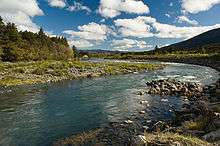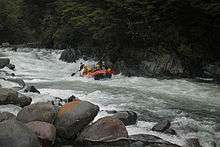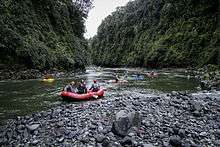Tongariro River
| Tongariro River | |
|---|---|
 Looking south towards the Hydro Pool | |
| Country | New Zealand |
| Basin | |
| Main source | Tongariro National Park |
| River mouth |
Lake Taupo 356 m (1,168 ft) |
The Tongariro River is a river in the North Island of New Zealand. The part of the Waikato River from the Waihohonu Stream, down to Lake Taupo, was formally named the Tongariro River in 1945.[1] The river originates in the Central Plateau of the North Island where it is fed by numerous tributaries (such as the Whitikau, Poutu, and Mangamawhitiwhiti streams) that flow off the surrounding hill ranges and mountains such as Mount Ruapehu. It then winds its way north, through the township of Turangi before entering Lake Taupo via a number of river mouths. The minimum volume of water flowing down the lower Tongariro River ranges from approximately 16 cubic metres per second (570 cu ft/s) (recorded at the upper rivers Poutu Intake)[2] to 21 cubic metres per second (740 cu ft/s) (recorded at the lower rivers Major Jones Pool).[3] This volume can substantially increase due to catchment of rainfall by the surrounding mountains and hill ranges.
The Tongariro River is New Zealand's most fished river,[4] and is a drawcard for anglers the world over, who come to the Tongariro to fish for spawning rainbow trout and brown trout, which run up the river from the lake to spawn over the colder winter months. Approximately 75% of the trout in the Tongariro are rainbow trout, and 25% are brown trout.
The Tongariro is classed as one of the best trout fishing rivers in the world, and part of its charm lies in its accessibility. New Zealand’s State Highway 1 follows the river for a number of kilometres providing anglers with easy access to the numerous pools and rapids. As many waterways in New Zealand are owned by the Crown, no one person has ownership of any stretch of water. For the cost of a Taupo Fishing Licence (NZ$90.00 for a 2012–13 seasonal licence) anyone can fish the river. It is therefore not unusual to see locals fishing alongside overseas anglers or celebrities (who are usually out with a guide).
Pools on the Tongariro River are usually named after historical people who have fished the river (Major Jones Pool, Duchess Pool), or their geographic location (Birch Pool, Fence Pool, Redhut Pool). Floods have significantly altered the size and shape of many of these pools (such as in 2004 when the Breakaway Pool was completely lost due a change in the rivers direction), while others such as the Major Jones Pool have remained relatively unchanged in the last 50 years.
Fishing techniques that prove to be popular include nymphing, wet lining and dry fly techniques. A fly fishing casting technique similar to a single handed spey cast called the Tongariro roll cast[5] was developed on this river. The name[6] was coined by Herb Spannagl who noticed its use on the Tongariro and felt it was sufficiently different from other casting techniques. The Tongariro roll cast is used to cast a fly line in situations where there are obstacles behind the caster that obstruct the angler from using traditional fly casting techniques.
Whitewater kayaking and rafting
The Tongariro River has 3 main sections of whitewater; named 'Access 14', 'Access 13' and 'Access 10'.[7] These sections are the most popular on the Tongariro and provide grade 4, 3+ and 3 whitewater respectively. Lesser run sections of grade 2 exist, the first of which runs down to the put-in of Access 14 and the lower section runs from Blue Pool to Turangi.[8] Sections of nearly unpaddleable whitewater fill the two main gorges, Tree Trunk Gorge and Waikato Gorge.
Recreational releases
The New Zealand Resource Management Act 1991 dictates that as part of mitigation for the loss of recreational amenities on the Tongariro River, Genesis Energy must divert water into natural riverbed for 3 weekends per year.[9] This is purely for recreational enjoyment and separate from any maintenance or flushing flows that are otherwise necessary. The dates for these releases are set in conjunction with the national body WhitewaterNZ and generally are structured such that Access 10 releases are on a Saturday and Access 14/13 are on the Sunday of the same weekend.[10] Flows of 30 cubic metres per second (1,100 cu ft/s) are released from Rangipo Dam for a duration of 8 hours.[9] Flows of 30 cumecs are released from the Poutu Intake for 6 hours.[9] The Access 14/13 sections are not able to be paddled without a release from Genesis Energy, due to the fact that the minimum required flow from below Rangipo Dam is negligible in terms of whitewater and the intake structure at Rangipo is able to take huge amounts of water; so if there is extra storm flow in these sections the flow is generally dangerously high. Access 10 is able to be paddled year-round as the minimum flow of 16 cubic metres per second (570 cu ft/s) below Poutu Intake is paddleable - albeit scratchy, and the amount of extra water able to be taken during storm events at Poutu Intake is relatively small so water is often spilled into the river.
Main whitewater sections
| Section name | Put in | Take out | Grade | Length | Time | Raft-able |
|---|---|---|---|---|---|---|
| Access 14 | Below Rangipo Dam | Before Tree Trunk Gorge | 4 | 5.7 km | 1 - 3 hours | Yes |
| Access 13 | Below Tree Trunk Gorge | Above Waikato Gorge | 3+ | 5.3 km | 2 - 3 hours | Yes, although access will
pose biggest difficulty |
| Access 10 | Below Poutu Intake | Blue pool | 3 | 13 km | 2 - 4 hours | Yes |
Access 14

This section is generally marketed as grade 4, which reflects more on the required skill of the paddler to complete this section - as in reality it only has a handful of grade 4 rapids. However, due to the continuous nature of the rest of its grade 3+ rapids, cold water and lack of ability to walk out, the section retains its grade 4 status. Access 14 is the highest of the three main sections and also the most narrow and steepest. Although the three sections receive the same amount of water on release days, the Access 14 section is the most confined and steepest, leading to bigger rapids, bigger pressure waves and deeper channels. Care must be taken to identify the takeout of this section, as immediately downstream is the deadly Tree Trunk Gorge section - mistakenly entering this section on a release day would almost certainly end fatally.
Access 13
In between Access 14 and Access 10 both geographically and in terms of difficulty lies the Access 13 section. This section weighs in at grade 3+ and requires hiking into and hiking out of, with another must make takeout; as the equally deadly Waikato Gorge lies just downstream. Access 13 requires some effort to get to, as getting to the put in requires walking from Tree Trunk Gorge road around Tree Trunk Gorge itself and lowering boats down a 15m cliff. Whilst the takeout requires walking around Waikato Gorge through some extremely overgrown bush tracks and plantation forestry. The rapids are most similar to Access 14, with a smaller riverbed constraining the rapids and making them more steep, with deeper channels than Access 10.
Access 10

The Access 10 section is the most popular run on the whole Tongariro River, owing to its ease of access, year round paddleable flows and 60+ grade 3 rapids. Below the Poutu Intake structure Genesis Energy are required to maintain a minimum flow of 16 cubic metres per second (570 cu ft/s) (for a number of ecological, aesthetic and recreational reasons) and this is enough to enjoyably kayak or raft the section - although on a release day the flow doubles and the rapids significantly improve. The rapids are all boulder gardens with deep clear water and fun pressure waves. This run can handle huge amounts of water before being considered a "flood run" and is great playboating at any level. Take out is generally at Blue Pool or you can continue down to Turangi township for a couple more kilometers of grade 2.
References
- ↑ Miles, Sue (1984). The River: The Story of the Waikato. p. 1. ISBN 0-86863-418-2.
- ↑ "Poutu Intake". Genesis Energy.
- ↑ "Tongariro River at Turangi". Genesis Energy.
- ↑ "Taupo Fishery". Department of Conservation (New Zealand). October 2006.
- ↑ "The Tongariro Roll Cast".
- ↑ "New Zealand Fly fishing-Tongariro Roll Cast video".
- ↑ "Sections in Tongariro | rivers.org.nz". rivers.org.nz. Retrieved 2015-08-02.
- ↑ "Tongariro / Blue Pool to Turangi, II | rivers.org.nz". rivers.org.nz. Retrieved 2015-08-02.
- 1 2 3 "Recreational Releases - Genesis Energy NZ". www.genesisenergy.co.nz. Retrieved 2015-08-02.
- ↑ "Events & Releases | rivers.org.nz". rivers.org.nz. Retrieved 2015-08-02.
External links
| Wikimedia Commons has media related to Tongariro River. |
- Tongariro River webcamera
- Tongariro River Map
- Advocates for the Tongariro River
- Hydrology Information at Major Jones pool
Coordinates: 38°56′17.00″S 175°46′51.70″E / 38.9380556°S 175.7810278°E